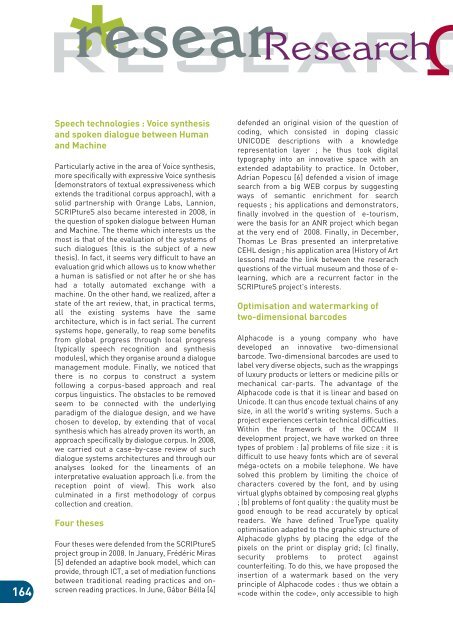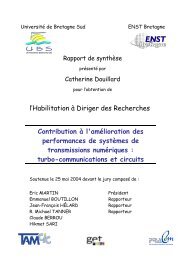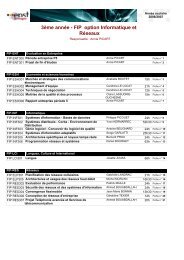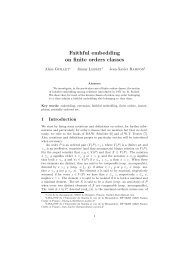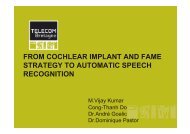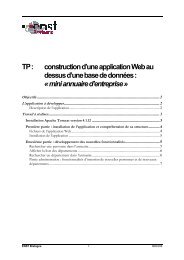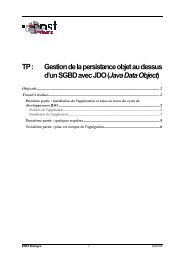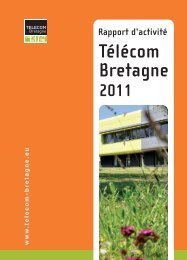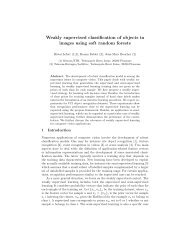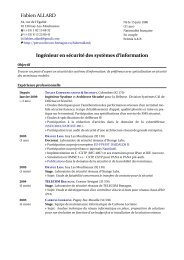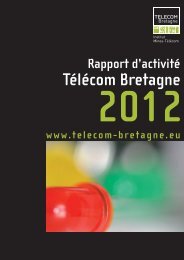researResearch - Télécom Bretagne
researResearch - Télécom Bretagne
researResearch - Télécom Bretagne
You also want an ePaper? Increase the reach of your titles
YUMPU automatically turns print PDFs into web optimized ePapers that Google loves.
esearc<br />
<strong>researResearch</strong><br />
164<br />
Speech technologies : Voice synthesis<br />
and spoken dialogue between Human<br />
and Machine<br />
Particularly active in the area of Voice synthesis,<br />
more specifically with expressive Voice synthesis<br />
(demonstrators of textual expressiveness which<br />
extends the traditional corpus approach), with a<br />
solid partnership with Orange Labs, Lannion,<br />
SCRIPtureS also became interested in 2008, in<br />
the question of spoken dialogue between Human<br />
and Machine. The theme which interests us the<br />
most is that of the evaluation of the systems of<br />
such dialogues (this is the subject of a new<br />
thesis). In fact, it seems very difficult to have an<br />
evaluation grid which allows us to know whether<br />
a human is satisfied or not after he or she has<br />
had a totally automated exchange with a<br />
machine. On the other hand, we realized, after a<br />
state of the art review, that, in practical terms,<br />
all the existing systems have the same<br />
architecture, which is in fact serial. The current<br />
systems hope, generally, to reap some benefits<br />
from global progress through local progress<br />
(typically speech recognition and synthesis<br />
modules), which they organise around a dialogue<br />
management module. Finally, we noticed that<br />
there is no corpus to construct a system<br />
following a corpus-based approach and real<br />
corpus linguistics. The obstacles to be removed<br />
seem to be connected with the underlying<br />
paradigm of the dialogue design, and we have<br />
chosen to develop, by extending that of vocal<br />
synthesis which has already proven its worth, an<br />
approach specifically by dialogue corpus. In 2008,<br />
we carried out a case-by-case review of such<br />
dialogue systems architectures and through our<br />
analyses looked for the lineaments of an<br />
interpretative evaluation approach (i.e. from the<br />
reception point of view). This work also<br />
culminated in a first methodology of corpus<br />
collection and creation.<br />
Four theses<br />
Four theses were defended from the SCRIPtureS<br />
project group in 2008. In January, Frédéric Miras<br />
[5] defended an adaptive book model, which can<br />
provide, through ICT, a set of mediation functions<br />
between traditional reading practices and onscreen<br />
reading practices. In June, Gábor Bélla [4]<br />
defended an original vision of the question of<br />
coding, which consisted in doping classic<br />
UNICODE descriptions with a knowledge<br />
representation layer ; he thus took digital<br />
typography into an innovative space with an<br />
extended adaptability to practice. In October,<br />
Adrian Popescu [6] defended a vision of image<br />
search from a big WEB corpus by suggesting<br />
ways of semantic enrichment for search<br />
requests ; his applications and demonstrators,<br />
finally involved in the question of e-tourism,<br />
were the basis for an ANR project which began<br />
at the very end of 2008. Finally, in December,<br />
Thomas Le Bras presented an interpretative<br />
CEHL design ; his application area (History of Art<br />
lessons) made the link between the reserach<br />
questions of the virtual museum and those of e-<br />
learning, which are a recurrent factor in the<br />
SCRIPtureS project's interests.<br />
Optimisation and watermarking of<br />
two-dimensional barcodes<br />
Alphacode is a young company who have<br />
developed an innovative two-dimensional<br />
barcode. Two-dimensional barcodes are used to<br />
label very diverse objects, such as the wrappings<br />
of luxury products or letters or medicine pills or<br />
mechanical car-parts. The advantage of the<br />
Alphacode code is that it is linear and based on<br />
Unicode. It can thus encode textual chains of any<br />
size, in all the world's writing systems. Such a<br />
project experiences certain technical difficulties.<br />
Within the framework of the OCCAM II<br />
development project, we have worked on three<br />
types of problem : (a) problems of file size : it is<br />
difficult to use heavy fonts which are of several<br />
méga-octets on a mobile telephone. We have<br />
solved this problem by limiting the choice of<br />
characters covered by the font, and by using<br />
virtual glyphs obtained by composing real glyphs<br />
; (b) problems of font quality : the quality must be<br />
good enough to be read accurately by optical<br />
readers. We have defined TrueType quality<br />
optimisation adapted to the graphic structure of<br />
Alphacode glyphs by placing the edge of the<br />
pixels on the print or display grid; (c) finally,<br />
security problems to protect against<br />
counterfeiting. To do this, we have proposed the<br />
insertion of a watermark based on the very<br />
principle of Alphacode codes : thus we obtain a<br />
«code within the code», only accessible to high


